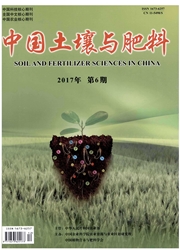

 中文摘要:
中文摘要:
选择棉花覆膜滴灌条件下长期连作棉田这一本区域典型的耕作栽培模式为研究对象,在石河子灌区设置膜下滴灌棉田土壤次生盐渍化定位监测试验,采用定位定时分层取样技术研究北疆滴灌棉田土壤盐分时空动态变化。结果表明,棉花整个生育期土壤盐分在水平方向上呈现明显的分区(脱盐区和积盐区)分布特征,膜内0-40 cm土壤盐分能维持在较低水平,脱盐效果显著,而膜外0-40 cm土壤盐分呈持续积盐趋势,40 cm以下各土层盐分变化幅度不大;土体垂直方向40-60 cm土层形成一个积盐区;各土层盐分随着地下水埋深的加大,土壤积盐率迅速降低;监测表明0-40 cm耕层土壤存在碱化倾向,土壤pH值年均递增0.09,年均积盐0.36 g/kg,照此积盐速度,轻度盐渍化耕地达到强度次生盐渍化水平(总盐含量20-30 g/kg)需要40-70年,达到中度次生盐渍化水平(总盐含量10-20 g/kg)需要15~40年。
 英文摘要:
英文摘要:
This study based on the cotton field of typical farming and cultivation style with drip irrigation for a long time in arid desert region of northern Xinjiang,using stratified sample method in fixed location and time to inquiry the variation of the cotton soil secondary salinization in Shihezi Irrigation Area.The results of locating and monitoring secondary salinization under mulch drip irrigation showed that: Soil salinity showed a apparent regional distribution characteristics(desalination and salt accumulation area)in the horizontal direction during all the cotton growth periods;Under membrane the 0~40 cm soil salinity could be maintained at a low level and the desalination results were obvious,while outside the mulch the 0~40 cm soil salinity accumulation was continuously improving in the cotton fields under mulch drip irrigation in north of Xinjiang.Soil salinity changes slightly below 40 cm soil layer.The vertical direction of the soil from 40~60 cm formed a salt accumulation zone;With the increasing depth of groundwater,soil salt accumulation rate decreased rapidly.In the monitoring periods,whether membrane or extracellular accumulation of various layers of salt would be in a salt state,and showed significant alkalization trends;0~40 cm topsoil increased at the rate of 0.036% average annual accumulation of salt,keeping on the same salt accumulation rate,mild salinization of arable land reaching the level of intensity of secondary salinization(total salt content of 2%~3%)would be around 40~70 years,and moderate secondary salinization levels(total salt content of 1%~2%)would require 15~40 years.
 同期刊论文项目
同期刊论文项目
 同项目期刊论文
同项目期刊论文
 期刊信息
期刊信息
